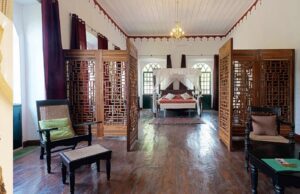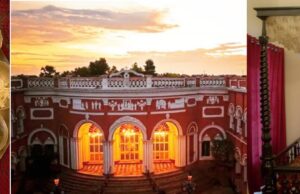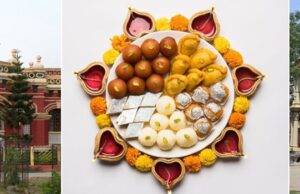
WoT's Hot
From Mark Twain to Satyajit Ray, Benaras is a city that has fascinated many. Often described as a place that is older than legend, this city is a magical blend of religion, mythology, culture, art, food, weaving and rich history.
True that the city is miles away from Bengal, but Bengalis are an integral part of the city’s culture. From a place of pilgrimage to garden houses for relaxation, Benaras or Kashi has been woven into our hearts in many ways.
This trip aims to explore the rich history of the city & its connection with Bengal in the most interesting way- a garden house.
Owning a Garden House or a residence in the middle of large lawns or gardens was extremely common for affluent families during the British Raj and a standing testimony to this once common way of living is the Dalmia Bhavan, a heritage building that was constructed in the 19th century, between 1835 and 1845.

History of the Dalmia Bhavan A witness to several historical events, this garden house was once the property of Raja Kishori Lal Goswami of the famous Goswami Rajbari in Serampore. Listed among the most prominent landlords and bankers of India, the title Raja was bestowed upon them by British Government and their royal seal can be seen at the rear gate of Dalmia Bhavan.
The Goswami’s had their Serampore home as well as this Benares property designed by the Dutch, and this particular style of architecture can be seen in both their homes. Historical Significance, the historical significance of the Dalmia Bhavan (once Goswami Bari) is immense.
a) Currently in India, except for Tranquebar & Serampore, buildings belonging to the Danish East India Company are extremely rare. The Dalmia Bhavan and its association with the Danish East India Company is quite evident, making it an invaluable architectural structure.
b) This house has been the witness to the struggle between the British and the Danish East India Companies on the banks of Ganges
c) This house has witnessed the transformation of Benaras from prosperity to penury and once again to its current glory.
d) The Freedom Fighters used to visit this house frequently. Dr. Annie Beasant, Mahatma Gandhi, Jawaharlal Nehru, Rabindranath Tagore, Sarojini Naidu and many others when visiting Benaras had stayed at this magnificent property.
e) Harivansh Rai Bachchan mentioned Dalmia Bhavan in his autobiography Neid ka Nirman Fir.

From Goswami Bari to Dalmia Bhavan-The Journey
The property which was an integral part of Indian history, was eventually sold to the philanthropic family of the Dalmia’s in the 1960s, and they are currently in talks with other luxury 5 Star Hotels to develop the same into a beautiful Heritage Boutique Hotel.
The Dalmia’s are not only a prominent business family but are also known for their interest in preserving Indian culture, and shared strong nationalist views, with a penchant toward service to the country.
The late Laxminiwas Dalmia (father of current owner of Dalmia Bhavan, Kunal Dalmia) donated a 425-room hostel in the memory of his father Late Duli Chandji Dalmia to BHU in 1973. This Hostel is popularly known as Dalmia Hostel. Further, a Home Science block for the students in BHU named “Savitri Devi Dalmia Vigyan Bhavan” was also donated to BHU.
This building has witnessed a fair share of experiences and events. From the onset of colonialization to the freedom of the nation under the able nationalist leaders, this house has been the silent observer to the transformation of not just a city but the entire nation. The gradual development of 200 years of Indian history can be seen in this building, as the building awaits a new transformation.
True that the city is miles away from Bengal, but Bengalis are an integral part of the city’s culture. From a place of pilgrimage to garden houses for relaxation, Benaras or Kashi has been woven into our hearts in many ways.
This trip aims to explore the rich history of the city & its connection with Bengal in the most interesting way- a garden house.
Owning a Garden House or a residence in the middle of large lawns or gardens was extremely common for affluent families during the British Raj and a standing testimony to this once common way of living is the Dalmia Bhavan, a heritage building that was constructed in the 19th century, between 1835 and 1845.

History of the Dalmia Bhavan A witness to several historical events, this garden house was once the property of Raja Kishori Lal Goswami of the famous Goswami Rajbari in Serampore. Listed among the most prominent landlords and bankers of India, the title Raja was bestowed upon them by British Government and their royal seal can be seen at the rear gate of Dalmia Bhavan.
The Goswami’s had their Serampore home as well as this Benares property designed by the Dutch, and this particular style of architecture can be seen in both their homes. Historical Significance, the historical significance of the Dalmia Bhavan (once Goswami Bari) is immense.
a) Currently in India, except for Tranquebar & Serampore, buildings belonging to the Danish East India Company are extremely rare. The Dalmia Bhavan and its association with the Danish East India Company is quite evident, making it an invaluable architectural structure.
b) This house has been the witness to the struggle between the British and the Danish East India Companies on the banks of Ganges
c) This house has witnessed the transformation of Benaras from prosperity to penury and once again to its current glory.
d) The Freedom Fighters used to visit this house frequently. Dr. Annie Beasant, Mahatma Gandhi, Jawaharlal Nehru, Rabindranath Tagore, Sarojini Naidu and many others when visiting Benaras had stayed at this magnificent property.
e) Harivansh Rai Bachchan mentioned Dalmia Bhavan in his autobiography Neid ka Nirman Fir.

From Goswami Bari to Dalmia Bhavan-The Journey
The property which was an integral part of Indian history, was eventually sold to the philanthropic family of the Dalmia’s in the 1960s, and they are currently in talks with other luxury 5 Star Hotels to develop the same into a beautiful Heritage Boutique Hotel.
The Dalmia’s are not only a prominent business family but are also known for their interest in preserving Indian culture, and shared strong nationalist views, with a penchant toward service to the country.
The late Laxminiwas Dalmia (father of current owner of Dalmia Bhavan, Kunal Dalmia) donated a 425-room hostel in the memory of his father Late Duli Chandji Dalmia to BHU in 1973. This Hostel is popularly known as Dalmia Hostel. Further, a Home Science block for the students in BHU named “Savitri Devi Dalmia Vigyan Bhavan” was also donated to BHU.
This building has witnessed a fair share of experiences and events. From the onset of colonialization to the freedom of the nation under the able nationalist leaders, this house has been the silent observer to the transformation of not just a city but the entire nation. The gradual development of 200 years of Indian history can be seen in this building, as the building awaits a new transformation.
From Mark Twain to Satyajit Ray, Benaras is a city that has fascinated many. Often described as a place that is older than legend, this city is a magical blend of religion, mythology, culture, art, food, weaving and rich history.
True that the city is miles away from Bengal, but Bengalis are an integral part of the city’s culture. From
True that the city is miles away from Bengal, but Bengalis are an integral part of the city’s culture. From
Other Articles in Wots Hot
What to read next
Featured articles

Welcome Festive Season in Glam, Latin Quarters Launches new #PujoBling Collection with Monami Ghosh
by WOT











































